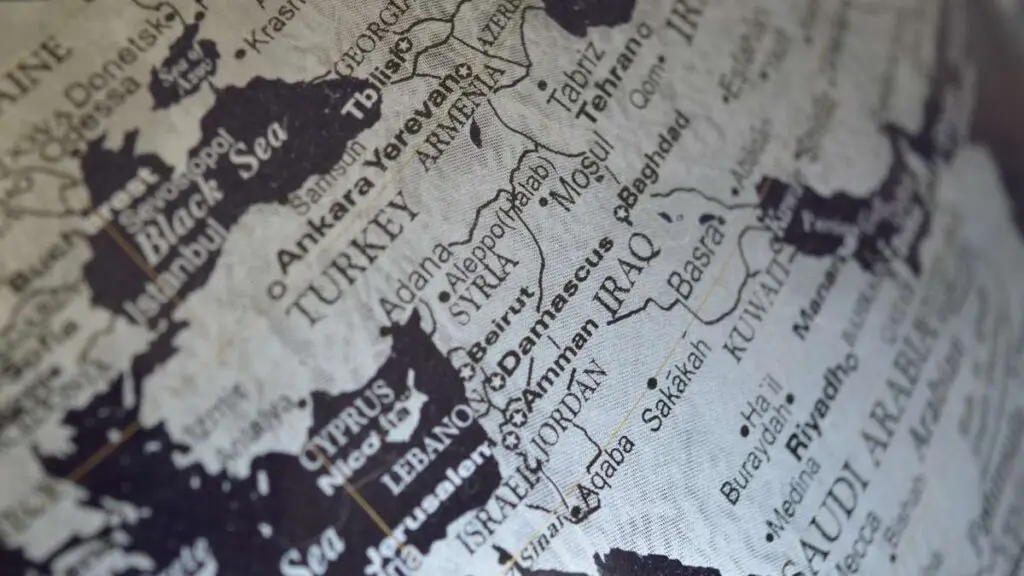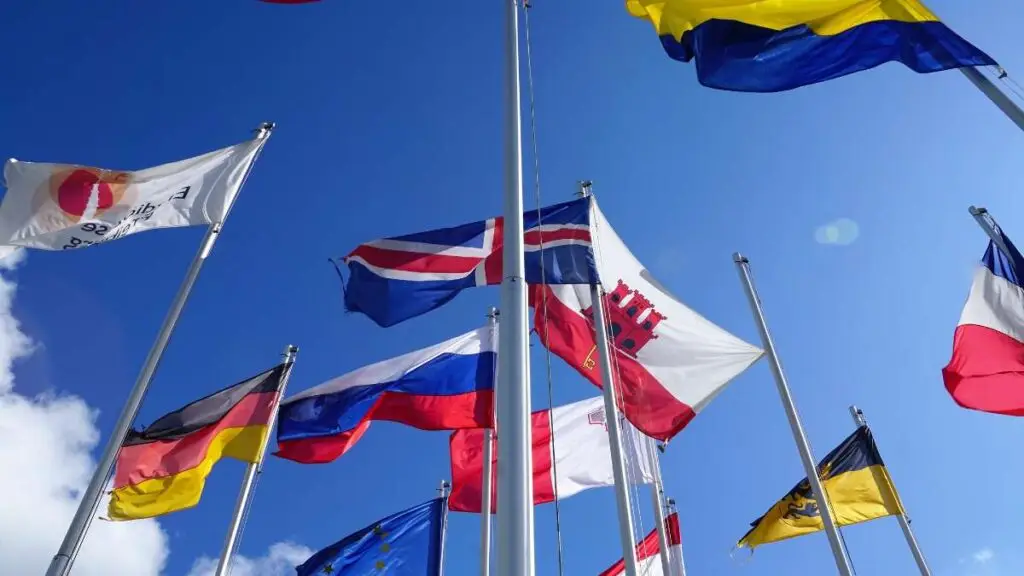Summer 2022/Volume VI, Number 2
Before he was actually president, Volodymyr Zelensky, a comedian, starred as Ukraine’s fictional president in his three-season political satire Servant of the People. He played a junior high teacher who asked his students to leave the classroom one day so he could have a word with a school administrator. In private, he launched a tirade against corruption in the education system, while a student secretly filmed him from an open window nearby. The rant went viral on YouTube, riling up Ukrainians who were tired of government shakedowns for basic education and health care, determined to replace their decrepit leaders.
Within weeks, the teacher, named Vasiliy, was elected president in the fictional show. He set out to reform the government, oust the oligarchs, and bring back integrity to Ukraine’s leadership. Terrified and alone in his bedroom, he had visions of receiving counsel from Abraham Lincoln; learned how to deal with the eccentricities of Barack Obama, Angela Merkel, and Vladimir Putin; and walked the tightrope between removing cronies from their offices and avoiding the anger of the political establishment that could unite against him.
There was a secret to Zelensky’s success, his friends and colleagues say. “We started filming Servant of the People with a broad sense of the storyline. The screenwriters kept track of the wild political situation in Ukraine, and wrote it into the script as it happened,” said Ekaterina Kisten, a Ukrainian actress. Kisten was a friend of Zelensky and grew close to him, playing his sister on Servant of the People. “We received the scripts only one day in advance of the shooting. The show was like a living organism.”
Zelensky’s ability to improvise his show based on political satire followed the pattern of how Ukraine united through, essentially, improvisation. Sudden and unforeseen hardships, followed by decisive leadership, forged the Ukrainian language, arts, and culture into a unified front during the previous two decades. Now, whatever the ultimate conclusion of the current conflict may be, it is clear that Ukraine has stood strong—and certainly proved more resilient than most predicted—against superior Russian firepower.
Servant of the People is perhaps the only fictional show to end because it came true. In 2019, Zelensky was swept into the presidency thanks to his populist, charismatic appeal, and with the support of well-heeled but questionable backers. Zelensky’s critics pointed out that he had a history of doing business with banking billionaire Igor Kolomoisky, whom the U.S. State Department sanctioned for his involvement in what it called “significant corruption.” Kolomoisky’s TV channel bought the rights to air Servant of the People. Zelensky invited people with links to Kolomoisky to serve in his administration.
Though Zelensky got off to a rocky start, with Ukrainians accusing him of being ineffective, his emergence as an international hero amid the Russian invasion in February 2022 marked a climactic turn in the unlikely story of Ukraine. Ukraine was always an abundant breadbasket with economic potential. But it was also ruined by mismanagement, kleptocracy, and poverty. President Zelensky’s ability to seize the moment was the latest in a series of dramatic shifts.
This unlikely renaissance poses knotty questions for America’s leaders as they decide which nations to support, defend, fund, or distance themselves from in foreign policy. Why do some countries, like Afghanistan, characterized for more than a century by similar problems of weak national identity and civic solidarity, corruption, and recently, the appearance of a hostile but inferior military force, succumb and collapse quickly? Why do others, like Ukraine, deeply corrupt and without Afghanistan’s $5 trillion in foreign military backing and twenty years of training, unite against overwhelming military odds?
I spent two weeks in Ukraine tracking down former colleagues and friends of President Zelensky, as well as Ukrainian advisers to earlier presidents, who had witnessed these changes firsthand. From their political offices and bunkers, they had seen key moments that galvanized the young Ukrainian nation. National solidarity and the will to fight define the new Ukraine. It is the kind of identity created through shows like Servant of the People that touched populist nerves.
“It wasn’t always like this, so united,” explains Maryna Kozachynska, a Ukrainian refugee in Warsaw, Poland, whose husband, a small business owner called to fight, stayed behind. “During the Holodomor, we didn’t have a strong national self.”
She was talking about Stalin’s intentionally created famine in Soviet Ukraine in 1932 that killed nearly four million people, slightly more than a tenth of the population, and began a wave of Soviet repression against Ukrainian intellectuals and artists. “Now we stand on our own. Finally, we have our own standing.”
The Formation of Ukrainian Identity after the Cold War
“For every two Cossacks, there are three leaders” is a Ukrainian proverb that sums up the truth of Ukrainian politics for most of its history. For centuries, the regions that make up Ukraine today were split up under the control of Polish, Lithuanian, Austro-Hungarian, and Russian powers. Ukrainian identity was weak, oppressed, and fractious, without a strong culture of government, education, publishing, and literature that could forge a national identity, and divided among fickle leaders whose allegiance was often to foreign meddlers.
Ukraine gained independence a generation ago, at the end of the Cold War in 1991. But at that time, Ukraine’s leaders still behaved like they represented an arm of Russia. Though Ukraine had free elections, it was also home to an ineffective and violent political elite, who pummeled each other in regular fistfights in the 450-person parliament, and pilfered what they could. Most Ukrainian leaders came from the Russian‑influenced east of the country. They were familiar with the Soviet art of siphoning off wealth from state industries and bureaucracies, corrupted to the core.
Without a functioning state to keep the oligarchs in check, Russia-style gangland killings were also common in Ukraine. The November 2000 “Cassette Scandal” was set off when President Leonid Kuchma was heard on tape ordering the murder of a Ukrainian journalist, whose body was found decapitated two months earlier. Another time, in 1999, the mayor of Lviv, in western Ukraine, demanded aid from European governments or else threatened to use the city’s factories to mass-produce small arms a two-hour drive from Poland.
Nevertheless, many western Ukrainians still saw themselves as the children of the western European tradition. They wanted the world to see them as liberal Europeans, too, not ex-Communists from the Soviet bloc, and they agitated for real democracy and an end to Russian-style oligarchy.
Ukraine’s first thrust away from Russian influence was in 2004, when the European Union welcomed neighboring Poland, Slovakia, and Hungary as new members. The EU wasn’t considering Ukraine as a member, but the EU expansion inspired demonstrations. The “Orange Revolution,” as it was called, further fractured Ukraine between the Russian-facing east and the EU- and NATO-facing west. A contest was emerging over national identity—are we European? Are we post-Soviet?—and it would bitterly divide Ukrainians in the decades to come.
Like the tire that hits the street, the frictions of the next decade propelled questions of Ukrainian identity forward, culminating in the 2014 crisis. Vladimir Putin, hoping to rein in a cousin that seemed increasingly distant, annexed the Crimea, fueled a separatist civil war in the east, and attempted to stop Ukraine from joining an EU trade pact, which Ukrainians saw as one step toward full EU membership. Ukraine’s then president, Viktor Yanukovych, was ousted when he opposed entry into the trade pact. He left Ukraine for exile in Russia and took Russian citizenship.
Russian propaganda described the ousting of Yanukovych as a staged protest orchestrated by the U.S. embassy and international organizations. In a leaked phone call, U.S. diplomats discussed the options for the next Ukrainian president and expressed frustration at the perceived inaction of the EU. One State Department official, Victoria Nuland, exclaimed, “F-ck the EU,” embarrassing the U.S. administration and appearing to give heft to Russian conspiracy theories that America would install a puppet government. Yet whatever support U.S. officials may have given to the demonstrators or to the new government, it is now clear that Ukrainian popular support was the basis for their success.
The Ukrainian Spring brought with it a newfound national strength that not everyone anticipated. “I didn’t think that Ukrainian identity would ever become homogeneous. I believed that different regions would remain different,” said Myroslav Marynovych, vice rector at the Ukrainian Catholic University in Lviv, and a former adviser to President Petro Poroshenko. “And they will remain culturally unique. But there would be a pro-Ukrainian element of all the population. We will all be united under a Ukrainian axis, or idea.”
The result was a renaissance in Ukrainian culture and language, which went beyond military defense capabilities and instilled a will to fight. In 2017, the government passed an education law that required Ukrainian to be the language of instruction from fifth grade onward. In 1991, the year of independence, more than half of high school students received instruction in Russian as their first language. In the three decades afterwards, the number fell to anywhere from one-fifth to one-third of schools teaching Russian as the primary language. Ukrainians achieved a 99.5 percent adult literacy rate—a feat elusive to Afghanistan, deeply divided between tribes and tongues, with an adult literacy rate of around 40 percent across the country’s multiple languages. (Forty languages are spoken in Afghanistan in addition to the dominant languages of Dari and Pashto.)
In 2017, the government passed another law that required TV and radio stations to broadcast three-quarters of their content in Ukrainian, placing limits on Russian-language broadcasts. Long before Americans were concerned about Russian disinformation, Russian propagandists had turned Ukraine into their testing laboratory, so much so that many Ukrainians were drowned in it during the 2010s.
Of course, Russia listed these media and educational restrictions among its justifications for invasion—Ukraine was teeming with fascists and nationalists who oppressed Russian-speaking minorities, they claimed—which is a backhand indication of the measures’ effectiveness and popularity. Or, stated another way, the last few months have shown that the language measures were not merely a top-down state imposition, but were the cause and consequence of a growing, independent sense of Ukrainian solidarity.
When Russia invaded Ukraine in February 2022, some American intelligence estimates predicted that Russia would easily gain the upper hand and would take the capital, Kyiv, in two days. Their predictions probably depended too much on raw military power, like the number of Russian tank columns and its air support capabilities, and underestimated Ukrainian resolve, assuming that divisive corruption and internal bickering would make Ukrainians less likely to resist a superior military force. But the Ukrainian people were surprisingly prepared. They had already spent two decades building their newfound unity against a shared enemy.
The Failure of Nation-Building in Afghanistan
If Ukraine is our era’s greatest success in the creation of a national culture and national solidarity, Afghanistan is its greatest failure. Both share similar circumstances, but experienced vastly different outcomes. They have been occupied by foreign powers, have become the center of intense geopolitical competition, have struggled under the leadership of divisive oligarchs, factions, or warlords, and have been ruled by repressive regimes that fomented high levels of corruption and low levels of trust.
While Ukraine shows how a nation can transform a fractious political culture, Afghanistan’s twenty-year saga under American occupation reveals that not every government can do the same. The idealism and money of outsiders cannot overcome the limits of a government’s will and ability to govern its people.
Despite American intelligence estimates that the Afghan national military could hold off the Taliban for six months or more, the Taliban swept through the capital, Kabul, within nine days in August 2020. Yet the Taliban had an inferior force, outnumbered by Afghan government soldiers four to one, and without air support against an American-trained, well-funded military. Why did Afghanistan fail so badly?
The exaggerated narrative of American military brutality against the local population (in the form of drone strikes, usually), inciting the majority of Afghans to embrace the Taliban and oust the occupiers, inaccurately places America at the center of Afghanistan’s destiny. It doesn’t adequately explain why Afghanistan’s U.S.-supported government quickly failed while Ukraine has proven resilient.
It’s true that the U.S. military failed to limit civilian deaths through drone strikes. It’s also true that the Afghan military proved an inept and unreliable fighting force, with “ghost soldiers” on its payroll and frequent desertions. But Afghanistan was always a low-intensity conflict in which a modest Taliban force, not a mass popular uprising, fought with heavy losses and little success against the American occupation.
This is a far different circumstance from the much more conventional war in Ukraine. While about 2,400 American soldiers died in Afghanistan in twenty years, as of this writing, Ukraine estimates that 18,900 Russian soldiers have died after two months of fighting, and NATO estimates that the number is between 7,000 and 15,000. One American general was assassinated in Afghanistan; six Russian generals have already died in Ukraine. In Ukraine, cities like Mariupol and Kharkiv have been reduced to rubble, and Russian soldiers have raped and executed civilians in Bocha, Chernihiv, and elsewhere. America’s mistake in its recent conflicts, on the other hand, has been to invade countries and then attempt to remake them in its image, with counter-insurgency doctrines.
Before the 1990s, Afghanistan and Ukraine looked like they were on a similar path. But their trajectories split after the end of the Cold War. When the Taliban took power in 1994, the Afghan people entered a social bargain with an oppressive Islamist regime. They exchanged centuries of instability, tribal warfare, and foreign invasion for a strict but reliable stability. The Taliban banned women from going to school, held public executions, and outlawed music, film, and the arts.
Americans didn’t understand Afghanistan’s tribal political culture, where loyalty to local militias, villages, and ethnic groups was stronger for the typical Afghan than loyalty to the modern, European-created nation-state, with borders drawn by British, Russian, and Soviet officials more than a century ago. Americans had unreasonable and idealistic expectations about what they could accomplish with outside help and money. Removing or killing Osama bin Laden and ousting al-Qaeda after the 9/11 attacks were realistic objectives. Expecting the majority of Afghan people, especially in the Pashtun regions in the south and east, to completely abandon the Taliban, however, was a tall order from the beginning.
While Ukraine was able to unite against Russian meddling, Afghanistan was never able to resist foreign influence on behalf of the Taliban. The Taliban received patronage from Pakistan and Saudi Arabia, who wanted to build a Sunni Muslim sphere of influence against their Shia rival, Iran. Pakistan’s leaders didn’t seem to realize how deep they were racing into the heart of darkness. “Once I gave the go-ahead that they [the Taliban] should get the money, I don’t know how much money they were ultimately given,” Benazir Bhutto, the prime minister of Pakistan at the time, later admitted in a 2002 interview. “I know it was a lot. It was just carte blanche.”
Since the Taliban had significant foreign funding and weapons, and banned pretty much anything that didn’t fit its medieval view of Islam, Taliban rule was the closest thing Afghans had to an identity that transcended tribal life. All this created a feedback loop in which religious extremism spilled into Pakistan, speeding up its loss of control over certain regions, which then spilled back into Afghanistan, strengthening the Taliban. Pakistan joined a long list of countries and homegrown Afghan modernizers and communists who had failed to grasp the complexities of tribal life outside the capital, Kabul.
Then America showed up in December 2001, toppling the Taliban but struggling to find an alternative leadership among the warlords and opportunists, and lacking the national structures and identities that could form the basis of a unified and modernized Afghanistan. America didn’t understand that Afghans, deeply divided and distrustful of each other, relied on webs of community networks that ensured their survival. Afghan fighters frequently made deals to switch sides, exchange soldiers, or mass defect in peaceful ways, keeping cities and villages relatively intact. Rival sides in war occasionally engaged in peaceful fighting as sport. Afghan families often sent their children to fight for different sides, with the goal of protecting the family from one side or the other.
For the next twenty years, the United States dumped $5 trillion into this perilous political system, money that typically didn’t help the people, but was laundered to the coffers of Afghanistan’s leaders or U.S. military contractors. “You just cannot put those amounts of money into a very fragile state and society, and not have it fuel corruption,” Ryan Crocker, the former U.S. ambassador to Afghanistan, said in 2016 to government investigators, a transcript published in the Afghanistan Papers. “You just can’t.”
Transparency International, the anti-corruption body, ranked Afghanistan among the most corrupt nations in 2021 at 174 out of 180 countries measured. Ukraine, meanwhile, was ranked 122, hardly a strong position, but still meaningfully better than Afghanistan’s.
The unscrupulous political culture of Afghanistan overpowered any gains made by the American occupation in health care, maternal mortality, and education levels—key indicators of prosperity. Between 2003 and 2015, child mortality, a key indicator of development progress, declined by 29 percent. Another study in the BMJ Journal of Public Health estimated that maternal deaths from childbirth were halved, from 1,140 deaths per 100,000 population in 2005 to 638 deaths per 100,000 population in 2017. From 2001 to 2017, the number of schools in Afghanistan had grown fivefold and their enrollment had grown almost tenfold. In 2001, about one million children, almost none of them girls, were enrolled in schools, while 9.2 million children were enrolled sixteen years later, almost 40 percent of them girls.
Afghanistan’s leaders had a number of opportunities to reform their politics in the same way that now allows for Ukraine to stand against Russian aggression. Awash with resources, they could have envisioned a modern nation-state with a fair and impartial central administration, a functioning education system, higher literacy rates, a more prosperous economy, and a shared national identity. Instead, they fled at the first sign of trouble without America to protect them.
Self-Determination and National Success Stories
After twenty years of struggle, President Zelensky became the hero of the moment, transitioning from a comedian and satirist in Servant of the People to the very symbol of national resistance against tyranny and aggression. After its own twenty years of struggle, Afghanistan crumbled to the Taliban regime. The majority of the population remains semi‑literate and disempowered.
In the end, regardless of U.S. foreign policy positions, the different trajectories of Afghanistan and Ukraine show that nations have their own capacities for self-determination, and nations choose their own futures. Ukraine is a lesson in how foreign invasion, as well as the higher pursuits of language, culture, and identity, can inspire a sense of national solidarity. Afghanistan is a lesson in how foreign intervention, money, and factionalism can erase the same dreams.
See Also:





